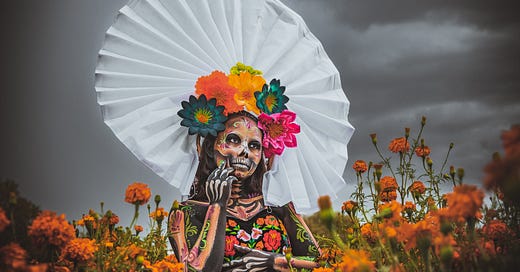Día de los Muertos is not the Mexican Version of Halloween
A brief explanation of Día de los Muertos
Día de los Muertos or The Day of the Dead is an evolving holiday tracing its earliest roots to the Aztec people celebrating and honoring those who have passed on and not a Mexican version of Halloween. While Halloween and Día de los Muertos fall close together on the calendar and share the common theme of death, the two holidays are vastly different, offering contrasting views and origins of traditions. On Día de los Muertos, it is believed that the border between the spirit world and the real world dissolves and for a small period of time, the souls are awakened and return to the living world to enjoy music, drink, food, and dance with their loved ones who remember them.
Dating 3,000 years ago, the Aztecs - who originated as a nomadic tribe in northern Mexico, arrived in Mesoamerica around the beginning of the 13th century. From their magnificent capital city, Tenochtitlan, the Aztecs emerged as the dominant force in central Mexico, developing an intricate social, political, religious and commercial organization that brought many of the region’s city-states under their control by the 15th century - and other Nahua people, established rituals of honoring the dead as they saw “death as an integral, ever present part of life.”
Upon dying, a person was believed to travel to Chicunamictlán, the Land of the Dead. Only after getting through nine challenging levels, a journey of several years, could the person’s soul finally reach Mictlán, the final resting place. In Nahua rituals honoring the dead, traditionally held in August, family members provided food, water and tools to aid the deceased in this difficult journey.
This inspired the ofrenda, an altar built in the homes of loved ones adorned with offerings mimicking that of the Nahua rituals like food, water and light. Family members light candles as a symbol of guidance on their journey. They add photos of their loved ones on the altar and read letters, sing songs, tell jokes and celebrate their life. Many place tequila, pan de muerto - a traditional Mexican sweet bread- and cempasúchil - also known as Marigolds - as added guidance for the souls to reach their final resting place. (Side Note: Here is a great story behind the use of the cempasúchil flower.)
“People are really dead when you forget about them, and if you think about them, they are alive in your mind, they are alive in your heart,” says Mary J. Andrade, a journalist and author of eight books about the Day of the Dead. “When people are creating an altar, they are thinking about that person who is gone and thinking about their own mortality, to be strong, to accept it with dignity.”
Another common image used in celebration of the Día de los Muertos is calaveras or skulls. They can be found made from papier-mâché, clay, wood, tissue paper among other materials. The calaveras is influenced by Mexcian artist José Guadalupe Posada’s famous etchings and illustrations of the Calavera Catrina.
In Mexico’s thriving political art scene in the early 20th century, printmaker and lithographer Jose Guadalupe Posada put the image of the calaveras or skulls and skeletal figures in his art mocking politicians, and commenting on revolutionary politics, religion and death. His most well-known work, La Calavera Catrina, or Elegant Skull, is a 1910 zinc etching featuring a female skeleton. The satirical work was meant to portray a woman covering up her indigenous cultural heritage with a French dress, a fancy hat, and lots of makeup to make her skin look whiter. The title sentence of his original La Catrina leaflet, published a year before the start of the Mexican Revolution in 1911, read “Those garbanceras who today are coated with makeup will end up as deformed skulls.”
Catrina became the public face of Día de los Muertos and the focal point of artistic activism demonstrating oppression and discrimination faced by the Mexican community. Famous Mexican muralist Diego Rivera, placed Catrina “in an ostentatious full-length gown at the center of his mural, completed in 1947, portraying the end of Mexico’s Revolutionary War. La Catrina’s elegant clothes of a “dandy” denote a mocking celebration, while her smile emerging through her pompous appearance reminds revelers to accept the common destiny of mortality.”
Since then, ofrendas have become an integrated part of public art to celebrate Mexican heritage but also to call out discrimination and hate. “In the 1980s, Day of the Dead altars were set up for victims of the AIDS epidemic, for the thousands of people who disappeared during Mexico’s drug war and for those lost in Mexico’s 1985 earthquake. In 2019, mourners set up a giant altar with ofrendas, or offerings, near a Walmart in El Paso, Texas where a gunman targeting Latinos killed 22 people.”
Though the customs of Día de los Muertos continue to evolve in large scale and with an undertone for the push for equality, the heart of the holiday remains the same: to remember and celebrate those who have passed on from this world while reminding us of our own mortality.




